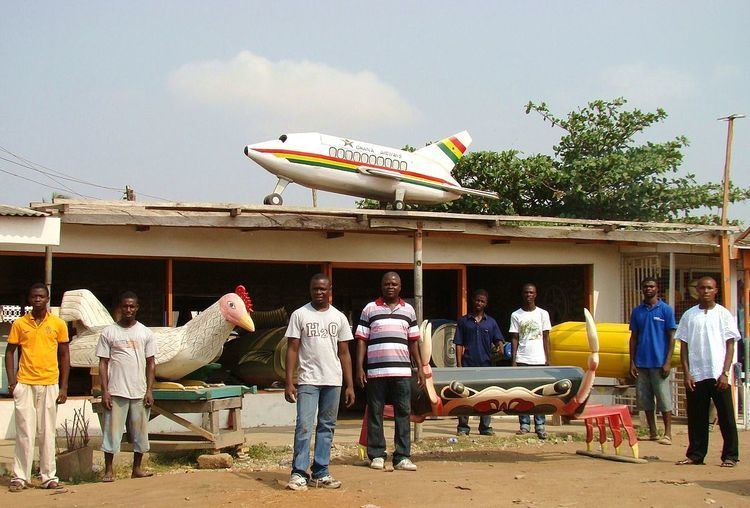 | ||
The Kane Kwei Carpentry Workshop is a studio established in Teshie, Ghana, since the 1950s. It is known for its design coffins that became symbolic of African artistic creativity.
Contents
History
Seth Kane Kwei (1922–1992) was a Ga carpenter joiner established in Teshie, in the suburbs of Accra in Ghana. He was a long time considered to be the inventor in the early 1950s of design coffins or fantasy coffins, called Abebuu adekai ("boxes with proverbs") by the Ga people, the dominant ethnic group of the region of Accra. Though, an anthropologist recently published a different story of the origin of the coffins.
As the anthropologist Regula Tschumi recently wrote, the figurative coffins developed out of the figurative palanquins which were formerly used like the figurative coffins in Accra only by the traditional chiefs. Around 1960 the use of figurative coffins for Ga burial rites became widespread. Design coffins are acknowledged as symbolic of contemporary creation in Africa.
At the death of Kane Kwei, his son Sowah took over the workshop, then Cedi - Kane Kwei's younger child - after the death of Sowah in 1999. Since 2005, Eric Adjetey Anang (born 1985, the son of Cedi) has been attempting to revitalize the creativity of the studio by the introduction of new models, the creation of furniture realized in the same spirit and using the same techniques as for the coffins.
About ten carpenters' workshops established in Teshie and in the region of Accra produce similar coffins. Some of their masters are like Paa Joe and Tei in Dorwanya former apprentices of Seth Kane Kwei. Others were trained by Kane Kwei's successors, mainly by Paa Joe. Among them are Daniel Mensah called Hello in Teshie, Tetteh in Amasaman and Tetteh Red in Ningo, Kudjoe Affutu in Awutu, Central Region, and Eric Kpakpo in La.
Manufacturing of the coffins
The Kane Kwei workshop is deeply anchored in Ga tradition, both by the genesis of its productions, by protocols framing their local use, and by its functioning based on apprentices, who can number about ten. At the end of the apprenticeship, which lasts from two to five years, a traditional ceremony is organized. In this occasion, the apprentice has to pay a sum of money, donate alcoholic drinks, a parasol, a pair of sandals to the boss of the workshop, and then a certificate is handed to him.
The manufacturing process of coffin begins by the scrupulous observation of visual documents reproducing the proposed model, or even the actual model - that could be a live animal - followed by its being realised in three dimensions. Neither plans nor sketches are prerequisite to the manufacturing. After the coffin is built, the inside is coated with a lining. The outside is carefully polished, sprayed, and finally decorated by a painter.
Light wood as wawa (white wood) or emien is used for the coffins intended for funerals. Those coffins intended for export as artworks are made from harder and more expensive wood, such as limba or African Mahogany.
Apparition of the studio's works on art market
While some figurative coffins were acquired in the 1970s by American gallery owners (Vivian Burns in 1973 and Ernie Wolfe, both from Los Angeles), it is since 1989 that these objects achieved international recognition as works of art, through their successive display in exhibitions: Magiciens de la terre (1989, Musée National d'Art Moderne (Centre Georges Pompidou) - Grande halle de la Villette, Paris - Curator Jean-Hubert Martin) and "Africa Explores" (1992, New Museum of Modern Art, New York - Curator Susan Vogel).
Pieces of the studio are part of major private collections including the Contemporary African Art Collection of Jean Pigozzi and many public collections.
At the initiative of the studio, artistic partnerships with Western institutions are implemented and residencies of foreign artists organized.
